名前:竹田 淳恵【京都大学大学院医学研究科腫瘍生物学講座】
発表日時:2017年6月24日
発表形式:Poster Pitch
Title:
Genetic landscape of acute erythroid leukemia
Authors:
June Takeda1, Lee-Yung Shih2, Kenichi Chiba3, Yuichi Shiraishi3, Yusuke Shiozawa4, Hideki Makishima1, Tetsuichi Yoshizato1, Yasunobu Nagata5, Akira Hangaishi6, Ken Ishiyama7, Akifumi Takaori-Kondo8, Keisuke Kataoka1, Masashi Sanada9, Hiroko Tanaka3, Kensuke Usuki6, Shuichi Miyawaki10, Satoru Miyano3, Arnold Ganser11, Michael Heuser11, Seishi Ogawa1, Felicitas Thol11 and Kenichi Yoshida1
Affiliations:
1 Department of Pathology and Tumour Biology, Graduate School of Medicine, Kyoto University, Kyoto, Japan
2 Division of Haematology-Oncology, Department of Internal Medicine, Chang Gung Memorial Hospital, Chang Gung University, Taoyuan, Taiwan
3 Human Genome Center, Institute of Medical Science, The University of Tokyo, Japan
4 Department of Paediatrics Graduate School of Medicine, The University of Tokyo, Japan
5 Department of Translational Haematology and Oncology Research, Taussig Cancer Institute, Cleveland Clinic, Cleveland, OH, United States
6 Department of Haematology, NTT Medical Center, Tokyo, Japan
7 Department of Haematology, Kanazawa University, Kanazawa, Japan
8 Department of Haematology / Oncology, Graduate School of Medicine, Kyoto University, Tokyo, Japan
9 Department of Advanced Diagnosis, Clinical Research Center, National Hospital Organization Nagoya Medical Center, Nagoya, Japan
10 Division of Haematology, Tokyo Metropolitan Otsuka Hospital, Tokyo, Japan,
11 Department of Haematology, Haemostasis, Oncology and Stem Cell Transplantation, Hannover Medical School, Hannover, Germany
Abstract:
Background: Acute erythroid leukemia (AEL) is a unique subtype of acute myeloid leukemia (AML) characterized by the predominance of erythroid components with increased ring sideroblasts as well as frequent myelodysplasia. However, due to its rarity, the molecular pathogenesis of AEL has not fully been elucidated, except for frequent TP53 mutations.
Aims: This study was designed to clarify the mutation profile of AEL distinct from other types of AML and myelodysplastic syndromes (MDS).
Methods: We performed a comprehensive genetic study, in which paired tumor/normal DNA from 22 AEL cases were analyzed using whole exome sequencing (WES). Whole-exome sequencing data from 3 AELs generated by The Cancer Genome Atlas (TCGA) was also included in the analysis. Subsequently, a total of 84 AEL cases were screened for mutations in 67 driver genes associated with myeloid malignancies using targeted-capture sequencing, in which RNA baits were also designed for a total of 1158 single nucleotide polymorphism sites to allow for genome wide copy number abnormalities and other allelic imbalances.
Results: Median age at diagnosis was 58.5 (21-87) years old. Among the 77 patients with clinical information available, 62 patients were diagnosed with de novo AML, 13 with secondary AML, and 2 with treatment-related AML. On average, 18.4 and 3.4 mutations were detected per sample in whole-exome and targeted-capture sequencing in AEL, as compared to 12.2 and 2.9 mutations (P < 0.001 and 0.05) in other AML, respectively. Both platforms being combined, most frequently observed was TP53 mutations (n=26, 31%) with complex karyotype being accompanied in most cases (25 cases), which were associated with a significantly shorter overall survival (P < 0.001). Other frequently mutated genes were those encoding major components of the cohesin complex, including STAG2 (24%), SMC1A (4.8%) and RAD21 (2.4%), which were mutated in as high as 30% of the cases. The splicing machinery (18%) and epigenetic regulators (45%) were also common targets of mutations, including SRSF2 (12%), U2AF1 (4.8%), WT1 (15%), TET2 (19%) and IDH1/2 (12%). TP53 mutations were mutually exclusive with cohesin mutations (p < 0.01) and those in epigenetic regulators (p = 0.014). Compared to other types of AML cases reported from TCGA, AEL showed a significantly higher frequency of mutations in TP53, STAG2, SRSF2, ASXL1, BCOR, WT1, and TET2. These mutations have previously been shown to be enriched in secondary AML and MDS relative to de novo AML, which were also confirmed in our analysis involving 2,250 MDS cases. By contrast, FLT3 (12%) and DNMT3A (12%) mutations and SF3B1 mutations (0%) were significantly less frequent in AEL, compared to de novo AML and MDS. The frequency of these mutations was not statistically different between de novo AEL and secondary AEL.
Conclusion: WES and follow-up targeted-capture sequencing revealed a landscape of mutations in AEL. Frequent mutations in TP53, splicing factors, the cohesin complex, and epigenetic regulators were characteristic of AEL and thought to be involved in its pathophysiology. Mutations in TP53 defined a subgroup with distinct genetic and prognostic features. Our result indicated a similarity between AEL and high-risk MDS/secondary AML, supporting the recent revision of the WHO classifications, in which AEL was re-classified into MDS and AML not otherwise unspecified.
EHA2017参加レポート
この度は22nd Congress of EHAに参加する貴重な機会を与えてくださり、誠に有難うございました。今年の開催地はスペインの首都であるマドリードであり、色彩豊かな活気あふれる都市で発表後の質疑応答の時間でも、また会場の外でもactiveな議論が交わされる国際学会でした。日差しが強く日中は気温が30℃を超えるのですが、湿度が低いため過ごしやすく、気持ちよく石造りの美しい街並みを歩いて会場に向かうことができました。
私の研究内容が骨髄腫瘍におけるゲノム解析であるので、その領域を中心に会場を回りました。研究領域における次世代シーケンサーによる研究が進み、多くの疾患における膨大なデータにアクセスできるようになりつつあります。その結果を踏まえて変異が疾患の発症、進展、そして表現型にどのように影響を与えるのか、またそれを阻害することによる治療標的としての評価など、遺伝子解析だけではなく、一歩踏み込んだ研究成果が数多く報告されていました。また胚細胞変異が小児発症のみならず成人発症の造血器腫瘍にも関与することが明らかになりつつあり、その適切な評価、治療についての検討もなされていました。胚細胞変異の研究は正確なリスク評価ももちろん重要ですが、治療の最適化に資するものであるべきであり、自分の研究の方向性を考える端緒を得ることができました。 また関心が高い腫瘍免疫、免疫異常においても多くのセッションが組まれており、再生不良性貧血、骨髄異形成症候群における制御性T細胞やアポトーシスを誘導する炎症性サイトカインの量的、機能的異常に対する理解を深めることができると同時に、免疫チェックポイント阻害薬が奏効するメカニズムへの最新の知見を学ぶことができました。
私の今回の発表内容である急性赤白血病(AEL) には他の急性骨髄性白血病 (AML)と比較し TP53、STAG2の変異が多いという特徴を持ちます。これらの変異がAELの病態や表現型にどのように影響を与えるのかという課題に対してSTAG2の機能解析をしている研究者と相互の研究について意見交換ができとても嬉しかったです。また検体収集など多大な尽力を頂いた台湾、ドイツの共同研究者と直接話し、これまでの研究の進捗、今後の研究内容について議論することができ、とても充実した時間となりました。自らの研究を様々な国の多くの分野の研究者に聴いていただき、助言や激励の言葉、互いの研究について議論ができたことが最大の収穫であったと思います。
国際学会に参加し世界を牽引する研究者の研究に触れる機会を通じて、ただ懸命に頑張るだけではなく、先を見通せるよう努力しつつ、着実な方法で目的を明らかに出来るような研究者になりたいと強く思います。まだまだ道のりは遠いですが、少しずつでも精進していきたいと存じます。
末尾になりますが、今回このような機会をいただきまして、日本血液学会 事務局、国際委員会の方々、また医学の進歩を願って検体を提供してくださった方々、そして日ごろから研究を指導してくださっている吉田健一先生、小川誠司先生に感謝いたします。



